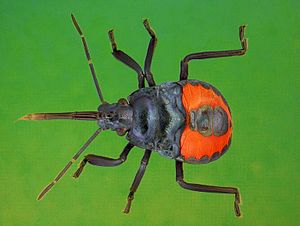Florida predatory stink bug facts for kids
Quick facts for kids Florida predatory stink bug |
|
|---|---|
 |
|
| Nymph | |
| Scientific classification | |
| Genus: |
Euthyrhynchus
|
| Species: |
floridanus
|
The Florida predatory stink bug (scientific name: Euthyrhynchus floridanus) is a special kind of insect found in the warmest parts of the southeastern United States. It's a type of shield bug that belongs to the Pentatomidae family. This bug is the only species in its group, called Euthyrhynchus. People consider it a helpful insect because it eats many kinds of pest insects, like grasshoppers and other small bugs. These stink bugs sometimes even hunt in groups of up to twelve!
Contents
What Does It Look Like?
Adult male Florida predatory stink bugs are about 12 mm (0.47 in) long. Females are a bit bigger, reaching up to 17 mm (0.67 in) in length. Their color can change, but they are usually bluish-black or purplish-brown. They have bright red spots on the sides and back of their scutellum, which is like a small shield on their back.
A cool feature is a clear spine on their humerus, which is part of their shoulder area. Unlike some similar bugs in Florida, this species does not have a spine on the underside of its front leg. The first part of their beak-like mouth is short and thick. This is different from their plant-eating relatives, which have thin mouthparts for sucking plant juices.
Life Cycle and What It Eats
Reproduction and Growth
The female Florida predatory stink bug lays groups of eggs, usually between twenty and ninety at a time. These eggs are shaped like tiny barrels and have small bumps around the edge of their cap, called an operculum.
When the eggs hatch, the young bugs are called nymphs. They grow through five stages, known as instars. In their early stages, their heads and chests are bluish-black, and their bellies are red. The youngest nymphs stay close to where their eggs hatched. Older nymphs also tend to stay together, sometimes even sharing a meal!
This bug takes longer to grow than its close relatives. For example, at 24°C (75°F), the eggs hatch in 35 days, and the nymphs take 65 days to become adults. If it's warmer, around 27°C (81°F), the eggs hatch in 20 days, and the nymphs develop in 40 days. Since the adult female takes about two weeks to mature and lays about 140 eggs in total, their numbers don't grow as fast as some other insects with shorter life cycles.
What They Eat
The Florida predatory stink bug is a great hunter! In labs, young nymphs have been seen eating many different types of insect larvae. These include larvae of the greater wax moth, the Mexican bean beetle, the tobacco budworm, and the black cutworm.
They also eat other insects like beetles, planthoppers, weevils, larvae of the long-tailed skipper, and even other stink bugs like the southern green stink bug. You can find these helpful bugs on many different plants, including ornamental plants, citrus trees, weeds, grasses, and other trees and bushes.
Images for kids



